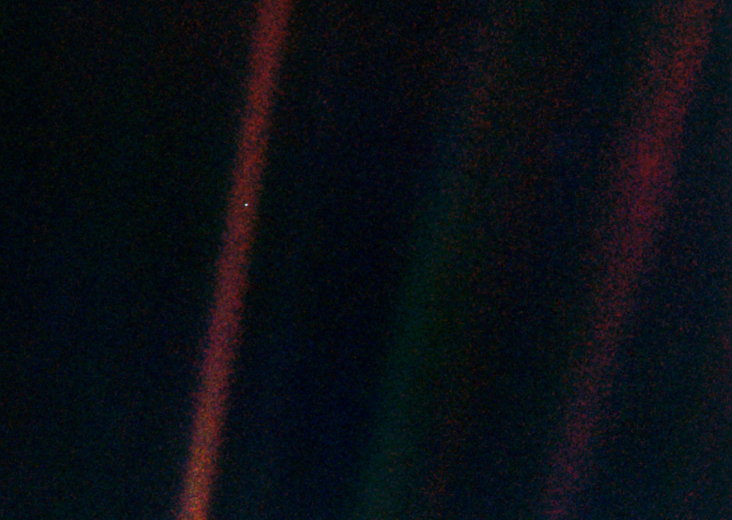Nothing speaks more to the change of seasons than the great bird migrations, and we love to tell this story in photographs. I found this interesting/amusing photograph by Fabian Bimmer for Reuters that tells a twist on that story. Swans from Hamburg’s inner-city lake Alster are migrating to their winter home – only they are transported there by boat and really seem to be enjoying the ride. The only thing that would be better is if they were being carried off by one of Boston’s famous “Swan Boats.” But their removal is also a sure sign of impending winter.
Final salute
I saw, this morning, a very touching a moving photograph by Nancy McKiernan / Baptist Health Nursing and Rehabilitation Center from Reuters. It shows United States Army veteran Justus Belfield, 98, who dressed in his uniform for a final time and saluted from his nursing home bed in Scotia, N.Y. on Veterans Day. Mr. Belfield was a World War II and Korean war veteran who served for sixteen years in the Army and fought in the Battle of the Bulge.t time. He died the next day.
Image of deepest into space

Figure 1 – The deepest image from the Hubble Space Telescope. ( NASA; ESA; G. Illingworth, D. Magee, and P. Oesch, University of California, Santa Cruz; R. Bouwens, Leiden University; and the HUDF09 Team).
There is another interpretation of the question of which space probe image is farthest away. This is the question of which image gives us a view deepest into space. As you might expect this answer comes from NASA’s Hubble Space Telescope. The image itself, shown here as Figure 1, called the eXtreme Deep Field, or XDF. is quite amazing in that it was “assembled” from ten years of photographs taken by Hubble of a single region of the sky in the southern constellation Fornax, at multiple wavelengths. There were fifty days of observation, and it combines approximately 2000 images, showing about 5,500 galaxies.
The XDF is the deepest image of the sky ever obtained. And most significant are the faint galaxies in the image. These date back 12.8 billion years, within a universe’s blink of the big bang that created it all 13.7 billion years ago. Truly we are looking at the cauldron of the gods.
We have spoken before about the ability of photography to take us back in time, and never is that more true than here. We are literally looking back in time. When you look up at the night sky, what you see is the light that simultaneously reaches you. But every star is light years away and as a result everywhere you look comes from a different point in time. The whole concept of simultaneity is turned on its head. Essentially what becomes important is not when things actually happened but what is captured by the telescope/camera in the instant of exposure. And even the term instant requires new definition. Is the combination of fifty days of long exposures really an instant?
A mere 300 million miles from Earth
Yesterday I spoke about the Philae comet lander. It is 300 million miles from Earth, and it made me wonder what the farthest out photograph ever taken was. Hmm, that sounds like pretty awkward English. Question, what space photograph was taken farthest from Earth? Ah, better!
On September 12, 2013, NASA announced that Voyager 1 had crossed the heliopause and entered interstellar space on August 25, 2012. That statement alone gives me goose bumps. But as for photographs, I’d like to start with Figure 1 which was actually taken by Voyager 2 of the planet Neptune at approximately 2.8 billion miles from Earth. Quick calculation friends, that’s about ten times further out than Philae and its comet. The Neptune image is so beautiful that I could not resist showing it.
But there are images from even further out! On February 14, 1990, at the suggestion of astronomer and fellow dreamer, Carl Sagan, NASA turned the cameras of Voyager 1 around and photographed all of the solar system from approximately 4 billion miles out. I think that so far this is the “farthest out” photograph ever taken. In this photograph planet Earth is a pale blue dot, a crescent 0.12 pixels wide.
On December 6, 2014 NASA will wake up its New Horizon’s space probe for the last time on its journey to Pluto and the Kuiper asteroids. That rendezvous is scheduled for next July 14th.
Philae and history

Figure 1 – Philae’s image from the surface of comet 67P/Churyumov-Gerasimenko. (c) 2014 ESA/Rosetta/Philae/CIVA
Sometimes you just know a historic image the moment that it is taken. A prime example of that is Figure 1 from the European Space Agency, which was taken by the Philae probe at 300,000 million miles from Earth on the surface of Comet 67P/Churyumov-Gerasimenko. This is a photograph for the ages. As most people know by now the probe is currently in the sleep of essential battery failure due to lack of light.
So, a number of thoughts come to mind. It is a truly amazing achievement. We have gotten so used to such achievements that we forget just how difficult they are. The physics and celestial mechanics that makes all this possible was developed by an impressive parade of great physicists, mathematicians, and astronomers: Johannes Kepler (1571–1630), Isaac Newton (1643–1727), Joseph-Louis Lagrange (1736–1813), Simon Newcomb (1835–1909), and Albert Einstein (1879–1955). Kudos to them all! But the required precision of steering is amazing. Head the slightest bit off course and you miss by millions of miles. Power is an issue. The time delay is so large that all the final maneuvers need to be done automatically driven by sensors either on the probe or on the Rosetta mother craft. Radio signals are so weak that sending back and receiving digital images is a tour de force. You’re always fighting signal-to-noise.
But the biggest questions is why do it. For those of us who truly believe that we are slowly but relentlessly freeing ourselves of the tethers that fetter us to Earth, it is a non question. We do it because it is hard, but when the third Fourth millenials will view it a thousand years from now in retrospect there will seem to be no question at all. But in our myopic, war and suffering filled world the value of reaching for the stars, of understanding the origins of life on Earth, seem eclipsed by everyday urgencies.
There are very few things that we do as a race that ennoble us, that point to an essential non-barbaric humanist curiosity. This may be the ultimate justification. We can close our eyes and see the future. At the same time, we can look about and see the minions, the intellectual army of creators, of scientist and artists. They are all dreamers – and therein lies mind spring that is the source of humanity.
Hooded Merganser – Lophodytes cucullatus

Figure 1 – Hood merganser group, male and two females, Blac’s Nook, Fresh Pond Reserve, Cambridge, MA. (c) DE Wolf.
To my eye, the most beautiful of the New England ducks is the Hooded Merganser – Lophodytes cucullatus. They migrate here in the fall and then again in April. The hoods on the males are beautiful as are the ruddy and gray fuzzy heads of the females. I have been trying to photograph them for about two years now. It required my big lens, since they like to stay on the unpeopled side of Black’s Nook and head over there at the first sign of human presence. Walk in their direction and they scatter dramatically, skirting over the water as if at play.
This particular morning, I decided to get them in my lens sights and just waiting. they rewarded me by coming within about 75 meters, which was enough to capture them with the lens fully extended. I just kept taking photographs and waiting for the right configuration and as a result was able to capture the image of Figure 1 of a male and two females swimming by. The male’s hood is not extended; but I really like the grouping. The image is a bit grainier than I like, a combination of using ISO 1600 and the need, even at this focal length to crop the final image.
Canon T2i, EF100-400mm f/4.5-5.6L IS USM Canon lens at 400 mm, IS 1 on, ISO 1600, Aperture-priority AE mode, 1/400th sec at f/8.0 with no exposure compensation, camera monopod mounted.
Updates at Hati and Skoll Gallery
I want to thank everyone for their continued support of Hati and Skoll Gallery. I have made several updates to the Galleries. Images from Kennebunkport, ME previously in the “New Gallery” have now been distributed to the other galleries and new images have also been added to these galleries. These include new bird photographs placed in the “Cabinet of Nature Gallery.” The “New Gallery” now contains photographs that I took in Madison, Wisconsin in early October 2014.
Thanks again to all of my friends and readers.
David
Fall of the Berlin wall

Figure 1 – The fall of the Berlin Wall, November 26, 1989. Image by Sharon Emerson and from the Wikimedia Commons under creative commons attribution license.
We mark this second week of November the fall of the Berlin wall, thirty-five years ago. The two words “Berlin Wall” conjure up many classic images – of its construction, of the cold war, of people trying to cross it, and of its fall. Perhaps most deeply are the images of President Kennedy speaking at the wall: “Ich bin ein Berliner.” It is an important symbol of the durability of human hope.
The image of Figure 1 is from November 1989 by Sharon Emerson and shows section of the wall covered with colorful graffiti. There is a hole in the wall through which and East German guard speaks to a westerner. It was a moment that slowly led to the reunification of Germany.
Imagining the wild in New York City
Yesterday I discussed the sensation of wondering just what it was like before North America was “civilized.” I used to do this as a child growing up in Manhattan in New York City. And it was a fantasy enhanced by a certain Twilight Zone episode “The Odyssey of Flight 33” in which a commercial airliner breaks the time barrier, while landing in New York City and is sent back first into the prehistoric age (Jurassic judging by the apatosaurs) and then to New York City of 1939. The tale is a modern telling of the Flying Dutchman myth.
Last holiday season I was given an amazing book entitled “Mannahatta: A Natural History of New York City” that tries to take us back. It is the decade-long work of landscape ecologist Eric Sanderson, who reconstructs in words and images the wild island that Henry Hudson first saw in 1609 and which nearly eight million people now call home. Sanderson re-creates the forests of Times Square, the meadows of Harlem, and the wetlands of downtown. Computer generated imagery truly takes us back to what it was like and I highly recommend this book to readers who share my childhood sense of wonder.


